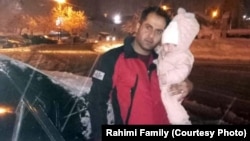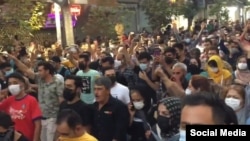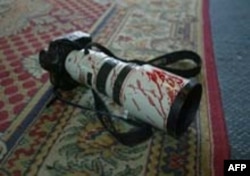Father Says Son Killed For Honking His Car Horn In Support Of Iranian Protests
- By Fereshteh Ghazi and
- Golnaz Esfandiari

Yahya Rahimi was driving to work when two men armed with large sticks attacked his car, shattering his windscreen.
As the 31-year-old slowly drove off, a gunshot was heard. Rahimi was dead, his bloodied head resting on the smashed driver’s window.
That is according to a video shared by Hengaw, a rights group registered in Norway that reports on Iran's Kurdish region.
Activists said Rahimi was targeted by plainclothes security agents on October 8 because he had honked his car horn in solidarity with anti-government protests in the northwestern city of Sanandaj, the provincial capital of Iran's Kurdistan Province.
Rahimi is among at least 300 people who have been killed in the government’s brutal crackdown on nationwide protests triggered by the death of Mahsa Amini, a 22-year-old woman, in September.
Ali Azadi, the head of Kurdistan’s police force, said Rahimi was shot dead by "anti-revolutionary forces." But his family says government forces killed him.
"Islamic republic agents had damaged his car, yet they didn't leave him alone," Rahimi's father, Ahmad Rahimi, told RFE/RL's Radio Farda. "A few steps further, they martyred him."
Ahmad Rahimi said the authorities had pressured him to declare his son was a member of the Basij paramilitary forces, a branch of Iran's powerful Islamic Revolutionary Guards Corps (IRGC), in an apparent attempt to blame his death on the protesters.
"When we received the body, the authorities said, 'We will register him as a martyr, you will receive [benefits], and we will give you blood money.' I told them I don't want such a thing."
Rahimi's father said police officers visited their home and offered condolences. But he responded, he said, by asking why they had killed his son.
"What crime did my son commit on that street? He was innocent. Why did you kill him?" he said, recalling what he told the officers.
Iran’s western Kurdistan region has become the epicenter of the months-long demonstrations raging in cities, towns, and villages across Iran and the focus of the government's bloody crackdown.
Amini's funeral in Kurdistan Province on September 17 was the catalyst for the protests. She died three days after she was arrested by Iran’s morality police for allegedly violating the country's mandatory hijab law.
Human rights groups say the authorities have intensified their crackdown in provinces with significant Kurdish populations, including Kurdistan, Kermanshah, and West Azerbaijan.
WATCH: Social-media video from Sanandaj, capital of the province, shows protesters hurling rocks at police and security forces allegedly using firearms, tear gas, and firing directly into residential homes.
Iran Human Rights (IHR), an Oslo-based group, said on November 5 that at least 60 people have been killed in the three provinces since the protests erupted. Overall, at least 304 people have lost their lives in demonstrations across the country, IHR said.
Over the weekend, Iranian security forces opened fire on protesters in the predominately Kurdish city of Marivan, wounding at least 35 people, according to Hengaw.
The protest was triggered by the death in Tehran of a Kurdish student from Marivan, Nasrin Ghaderi, who according to Hengaw died on November 5 after being beaten by police.
Videos posted on social media showed protesters throwing stones at a government building and burning the Iranian flag.
State media quoted a local prosecutor as saying Ghaderi’s body showed no signs of trauma and she had died from alleged poisoning.
The Kurdistan Human Rights Network said on November 6 that security forces in Marivan had used tear gas and fired metal pellets at protesters.



